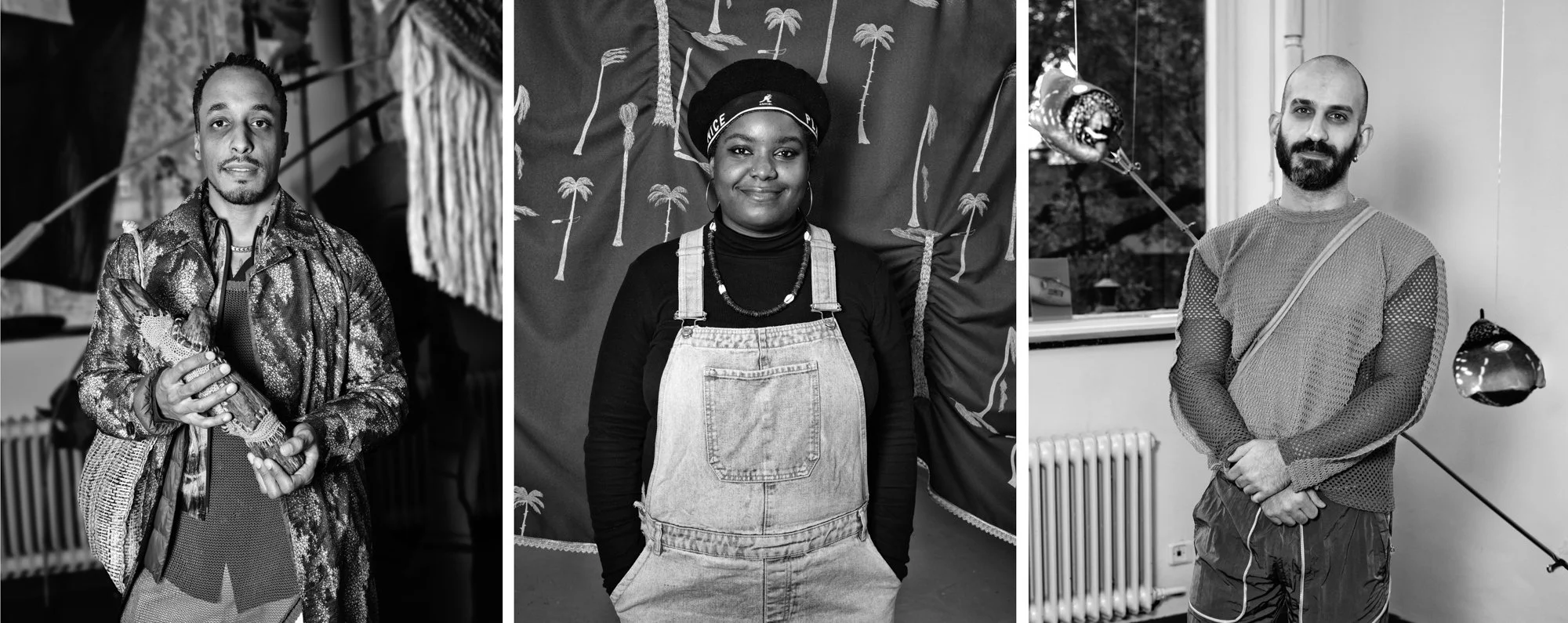Rafael Edem Kouto, Gwladys Gambie, and Rouzbey Shadpey in their studios at the Jan van Eyck Academie (October 2025, Maastricht, The Netherlands).
In the heart of Maastricht, the Jan van Eyck Academie stands as a quiet yet potent sanctuary for contemporary thought and creation. It is not an art school, nor a gallery, but something in between: a place where artists, designers, and thinkers from all over the world come together to reimagine what art can be when given time, trust, and tools.
Walking through the studios during the Open Studios days feels like entering parallel worlds. Each resident unfolds a vision that stretches beyond their discipline—woven through questions of history, identity, and repair. Among them this year: Rafael Edem Kouto, Gwladys Gambie, and Rouzbeh Shadpey — three distinct voices united by a shared urgency to heal and reimagine.
Rafael Edem Kouto
Rafael Kouto, a Swiss creative director and fashion designer of Togolese and Ghanaian origin, builds his practice on the ethics of reuse and cultural continuity. His work, deeply rooted in West-African material culture, embraces upcycling as both method and message. By transforming discarded textiles and objects, Kouto turns what was once waste into a vehicle of memory and renewal.
His ongoing project Artefacts & Notes from Altared Futures – Temporarily Closed for Healing examines portable artifacts that once travelled across the Atlantic with the slave trade — talismans, fabrics, small objects that survived displacement. Through these, Kouto forges an emotional connection between craft and spirituality, between what is lost and what can still be made sacred again.
Gwladys Gambie
From Martinique, still formally a French colony, Gwladys Gambie brings to Maastricht a dreamlike yet defiant visual universe. Her work explores the representation of Caribbean black bodies and the female condition under the long shadow of colonialism. Through drawing, painting, writing, and performance — and lately through embroidery — she builds an oneiric space where fantasy and critique meet.
In her project Metaphor of the Coconut Tree, Gambie confronts “doudouism,” the exoticized image of the Caribbean perpetuated by literature and tourism. Her hand-drawn portraits of trees and textile installations challenge the coconut’s lazy association with paradise, instead revealing the violence of history embedded in its trunk and leaves. Each stitch, each line, becomes an act of reclaiming narrative — turning ornament into testimony.
Rouzbeh Shadpey
Physician, writer, and artist Rouzbeh Shadpey brings the language of the clinic into dialogue with the language of poetry. His research unpacks the aesthetics of chronic fatigue and the colonial legacy of medical power. Through video, sound, and text, Shadpey transforms the experience of illness into a site of resistance — a way of thinking that honours those whose suffering has been dismissed as “medically contested.”
In his installation Musique Chronique, he stages a scenography that may or may not unfold into performance — an unfinished ritual about the transformation of pain into music. Elsewhere in the academy, a second intervention mirrors the first: not music as healing, but music as illness, a meditation on the dissonance between harmony and violence. His work resonates as both a lament and a call for empathy — an appeal for recognition of human vulnerability in times of devastation.
A house for multiplicity
Together, these artists exemplify what the Jan van Eyck Academie does best: it shelters voices that speak from fracture, from history, from the desire to mend. Here, discarded fabric becomes altar cloth; embroidery becomes resistance; sound becomes protest.
The academy’s studios are not quiet after all — they hum with the slow, persistent work of reimagining the world.


